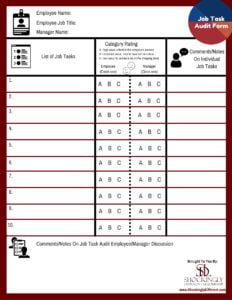High Potentials don’t get that title by being average. They love to take the reigns to lead others to a better reality – and this includes helping their employers determine where their time is best spent at work, through job task audits.

Written by
Karan Rhodes
Within organizations, “high potential” leaders are employees who have the aspiration, ability and commitment to be promoted 1-2 levels in a relatively short time frame. This pool of employees are often considered to be the leading candidates to become the future leaders of the company.
High Potentials don’t get that title by being average. They love to take the reigns to lead others to a better reality – and this includes helping their employers determine where their time is best spent at work. They are masters at getting buy-in from their manager on what tasks to eliminate or delegate off their plate in order to optimize their time on on more highly-valued initiatives. These conversations are called Job Task Audits (JTA).
Job Task Audits can be implemented company-wide, but at a minimum, I highly recommend all leadership development programs include a workshop which teaches high potentials and their managers how to conduct an annual JTA.
Here’s why:
The job description is the mother of all HR processes. Everything from recruitment and training to performance evaluations and compensation all stems from the job tasks listed in the job description. Without a regular Job Task Audit, managers aren’t fully aware of how you really split your time 40 hours a week and if you are compensated fairly for the real work that you do.
 Also, did you you know that only 34% of job descriptions are updated every 5 years? This means that there is a high probability that the tasks in the job description when your were hired have changed quite a bit and no one has updated it in the human resources systems.
Also, did you you know that only 34% of job descriptions are updated every 5 years? This means that there is a high probability that the tasks in the job description when your were hired have changed quite a bit and no one has updated it in the human resources systems.
Think about it. What job do you know is the exact same as it was 5-7 years ago? For instance, in my last corporate job, my job description only described 40% of what I really did. When I left to start my own leadership development firm, I informed my manager to be sure to include the additional 8 job tasks which I shared with her. Otherwise, my back fill would not have a full picture of the expectations of the the position.
Ideally, Job Task Audits should occur separate from the employee’s performance review. The purpose of a performance review is to compare job performance against work goals. The purpose of the Job Task Audit is to prioritize, edit and/or reshuffle work goals. These two very different conversations should be had separately, in order to eliminate any misunderstandings or confusion.
Unfortunately, how to have a Job Task Audit conversation is rarely taught to employees and their managers, even though research shows that the results of such conversations has an 82% success rate in positively impacting both business metrics and employee engagement.
In order to help build your leadership brand, you should have an opinion on how to more effectively use your time on “what matters most” versus “what is on your plate right now”.
Here is a little insight on how some high potential leaders reinvent their job description:
As they review the tasks in their job description, they place each of the job tasks into one of 3 categories:
- Category A: high value; critical to the company’s success
- Category B: moderate value; nice to have but not critical
- Category C: low value; for review to be on the chopping block
In most cases, those tasks in Category C are taking up a lot of your time and aren’t helping to improve business metrics like sales revenue, efficiency or customer satisfaction.
A high potential leader is expected to reduce or get rid of those Category C tasks which their manager agrees no longer make sense to do. High potential leaders gain credibility and increase their value when they have a strong perspective on where they should best spend their time in order to exceed the team’s goals.
In order to do this, high potential leaders must stay keenly focused the entire year on monitoring and documenting what they do, how they do it, and an assessment of the results. Top performers want to ensure that they are always where they want to be on all three dimensions. Also, when high potential leaders are promoted, Job Task Audits make it easier to hire a great replacement who has the exact skills needed for the job.


My challenge for you: Request a meeting with your manager to conduct a Job Task Audit. Figure out which tasks are serving the best long term goals of your team and advocate for those during your JTA. Also, don’t forget to include those additional tasks that you are doing but are not listed in your job description.
Need a headstart? Download this free 3-page PDF guide on how to prepare for and conduct your own Job Task Audit. It includes a done-for-you JTA outline, talking points for JTA conversations, and invaluable additional tips to help you become an even stronger leader.



